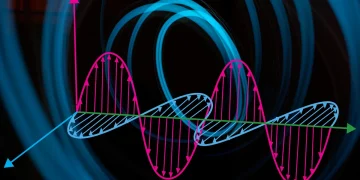In the vast electromagnetic spectrum that surrounds us, much more exists than meets the eye. Beyond the familiar visible light that paints our world with color, lies a realm of invisible energy known as infrared radiation. While we may not be able to see it, its effects and applications have profoundly shaped various aspects of our lives.
Understanding Infrared Radiation:
Infrared radiation (IR) is a type of electromagnetic radiation that has wavelengths longer than visible light and shorter than radio waves. It is invisible to the human eye, but we can feel it as heat. In fact, almost all objects in the universe emit some level of IR radiation, depending on their temperature. The hotter an object is, the more IR radiation it emits.
Sources and Types of Infrared Radiation
The main source of IR radiation on Earth is the Sun, which emits about half of its energy in the form of IR The Earth absorbs some of this IR radiation and reflects the rest back to space. The atmosphere also absorbs and emits IR radiation, creating a greenhouse effect that keeps the planet warm
Other sources of IR radiation include stars, planets, comets, asteroids, nebulae, galaxies, and black holes. Some of these sources are very distant and have very low temperatures, so they emit IR radiation at very long wavelengths. These are called far-infrared sources and can only be detected by special telescopes in space
On the other hand, some sources are closer and have higher temperatures, so they emit IR radiation at shorter wavelengths. These are called near-infrared sources and can be observed by optical telescopes or infrared cameras. Some examples of near-infrared sources are human beings, animals, plants, fires, volcanoes, and lightning
Infrared radiation can be divided into three regions based on its wavelength: near infrared (NIR), with wavelengths from 0.78 to 2.5 micrometers; mid-infrared (MIR), with wavelengths from 2.5 to 50 micrometers; and far-infrared (FIR), with wavelengths from 50 to 1000 micrometers Each region has different properties and applications
Applications and Uses of Infrared Radiation
Infrared radiation has many uses in science, technology, medicine, industry, military, and everyday life. Some of the most common applications are:
- Infrared spectroscopy: This is a technique that uses IR radiation to identify the chemical composition and structure of molecules. By measuring the absorption or emission of IR radiation by different bonds and groups in a molecule, one can determine its molecular fingerprint. This technique is widely used in chemistry, biology, physics, astronomy, geology, and environmental science.
- Infrared imaging: This is a technique that uses IR cameras to capture images of objects or scenes that are invisible to the naked eye. By detecting the heat emitted by different objects or regions, one can create a thermal map that shows their relative temperatures and contrasts. This technique is useful for night vision, security, surveillance, firefighting, medical diagnosis, wildlife observation, archaeology, art restoration, and more.
- Infrared communication: This is a technique that uses IR signals to transmit data or information between devices or systems. By modulating the intensity or frequency of IR beams, one can encode messages or commands that can be received by sensors or receivers. This technique is used for remote controls, wireless headphones, printers, scanners, keyboards, mice, and other devices that need short-range communication without wires or interference.
- Infrared heating: This is a technique that uses IR lamps or panels to generate heat for various purposes. By emitting IR radiation that can penetrate deep into materials or tissues, one can create a uniform and efficient heating effect that does not require contact or convection. This technique is used for cooking, drying, curing, sterilizing, welding, soldering, therapy, sauna, and more.
Conclusion
Infrared radiation is a fascinating phenomenon that has many applications and benefits for humanity and nature. By understanding its properties and uses, we can appreciate its role in our lives and explore its potential for further innovation and discovery.






























